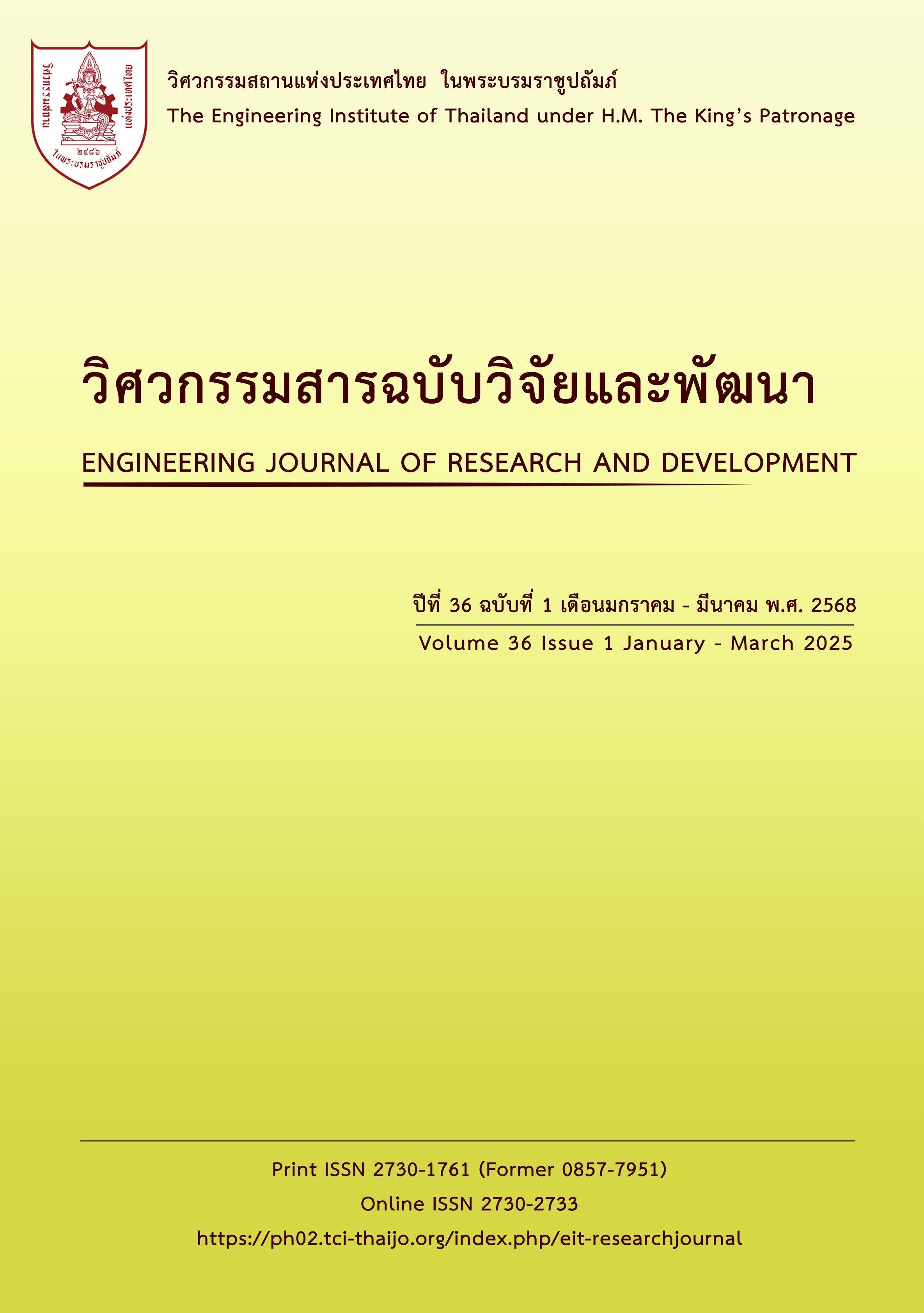PERFORMANCE OF RAILWAY BALLAST IMPROVED WITH TIRE-DERIVED AGGREGATE UNDER CYCLIC LOADING
Main Article Content
Abstract
The deterioration of ballasts is caused by abrasion and crushing under the dynamic load of the train until they break into powder. This eventually causes the need to clean or replace the ballast. This research focuses on a study to improve the ballast layer by partially replacing the ballast with recycled tire-derived aggregate (TDA). Because of its elastic properties, tire scraps are an alternative for research. The laboratory testing series was conducted, consisting of the physical properties test of ballast, design, and construct the ballast box test. The ballast and TDA were prepared with different TDA as 5%, 10%, and 15% (by volume of ballast) and performed under cyclic loading. Finally, an optimum TDA content was suggested to decrease the ballast deterioration. The result found that in the case of ballast mixed with TDA, the ballast breakage values have a decrease trend with mixed TDA of 5% and an increase trend when TDA is more than 5%. The strength behavior of the ballast layer is described by the vertical settlement, vertical stress, stiffness, and damping ratio values, it was found that when the ballast layer is loaded, plastic deformation will occur rapidly up to approximately 1,000 cycles, after which the rate of settlement will gradually decrease when the load reaches approximately 10,000 cycles, and then it will remain stable with almost constant settlement. Considering the deterioration pattern and strength behavior of the ballast layer, it was found that using recycled TDA in the ballast layer in an amount not exceeding 15% by volume of ballast that can be moved and rearranged appropriately can significantly reduce the deterioration of the ballast track.
Article Details

This work is licensed under a Creative Commons Attribution-NonCommercial-NoDerivatives 4.0 International License.
The published articles are copyright of the Engineering Journal of Research and Development, The Engineering Institute of Thailand Under H.M. The King's Patronage (EIT).
References
มาตรฐานการขนส่งทางราง. มขร. C-007-2566. มาตรฐานการออกแบบทางรถไฟชนิดมีหินโรยทาง. กรุงเทพฯ: กรมการขนส่งทางราง, 2566.
Indraratna, B. Salim, W. and Rujikiatkamjorn, C. Advanced rail geotechnolgy ballasted track, London: CRC Press, 2011.
ธวัช จิ้วบุญชู และ พิษณุ พลกายนุวัตร. กรณีศึกษาปรับปรุงโครงสร้างทางรถไฟส่วนล่างด้วยวัสดุเสริมกำลังทางปฐพี. การประชุมวิชาการวิศวกรรมโยธาแห่งชาติครั้งที่ 26. วันที่ 23-25 มิถุนายน 2564, หน้า INF-12-1 ถึง INF-12-8.
Indraratna, B. Qi, Y. Malisetty, R. S. Navaratnarajah, S. K. Mehmood, F. and Tawk, M. Recycled materials in railroad substructure: an energy perspective. Railway Engineering Science, 2022, 30, 304–322. https://doi.org/10.1007/s40534-021-00267-6.
Sol-Sánchez, M. Thom, N.H. Moreno-Navarro, F. Rubio-Gámez, M.C. and Airey, G.D. A study into the use of crumb rubber in railway ballast. Construction and Building Materials, 2015, 75, pp.19–24. https://doi.org/10.1016/j.conbuildmat.2014.10.045.
Hussaini, S. K. K. Indraratna, B. amd Vinod, J. S. A laboratory investigation to assess the functioning of railway ballast with and without geogrids. Transportation Geotechnics, 2016, 6, pp. 45-54. https://doi.org/10.1016/j.trgeo.2016.02.001.
Esmaeili, M. Aela, P. and Hosseini, A. Experimental assessment of cyclic behavior of sand-fouled ballast mixed with tire derived aggregates. Soil Dynamics and Earthquake Engineering, 2017, 98, pp. 1–11. https://doi.org/10.1016/j.soildyn.2017.03.033.
Navaratnarajah, S. K. and Indraratna, B. Use of rubber mats to improve the deformation and degradation behavior of rail ballast under cyclic loading. Journal of Geotechnical and Geoenvironmental Engineering, 2017, 143(6). https://doi.org/10.1061/(ASCE)GT.1943-5606.0001669.
Indraratna, B. Sun, Q. Heitor, A. and Grant, J. Performance of rubber tire-confined capping layer under cyclic loading for railroad conditions. Journal of Materials in Civil Engineering, 2018, 30(3). https://doi.org/10.1061/(ASCE)MT.1943-5533.0002199.
Indraratna, B. Qi, Y. Ngo, T.N. Rujikiatkamjorn, C. Neville, T. Ferreira, F.B. and Shahkolahi, A. (2019). Use of geogrids and recycled rubber in railroad infrastructure for enhanced performance. Geosciences, 9(30). doi: 10.3390/geosciences9010030.
Song, W. Huang, B. Shu, X. Wu, H. Gong, H. Han, B. and Zou, J. Improving damping properties of railway ballast by addition of tire-derived aggregate. Transportation Research Record, 2019, 2673(5), DOI: 10.1177/0361198119839345.
Esmaeili, M. and Askari, A. Laboratory investigation of the cyclic behavior of rock ballast mixed with slag ballast for use in railway tracks. Construction and Building Materials, 2023, 365, https://doi.org/10.1016/j.conbuildmat.2022.130136.
สำนักงานนโยบายและแผนการขนส่งและจราจร. คู่มือการออกแบบและก่อสร้างโครงสร้างทางรถไฟ. กรุงเทพฯ, 2561.
American Railway Engineering and Maintenance of Way Association. AREMA: 2012. Manual for railway engineering. Lanham, MD, 2012.
Lackenby, J. Indraratna, B. McDowell, G. and Christie, D. Effect of confining pressure on ballast degradation and deformation under cyclic triaxial loading. Geotechnique, 2007, 57(6), 527–536. https://doi.org/10.1680/geot.2007.57.6.527.
Indraratna, B. Lackenby, J. and Christie, D. Effect of confining pressure on the degradation of ballast under cyclic loading. Géotechnique, 2005, 55(4), pp. 325–328. https://doi.org/10.1680/geot.2005.55.4.325.
Indraratna, B. and Nimbalkar, S. Stress-strain degradation response of railway ballast stabilized with geosynthetics. Journal of Geotechnical and Geoenvironmental Engineering, 2013, 139(5), pp. 684–700. https://doi.org/10.1061/(ASCE)GT.1943-5606.0000758.

